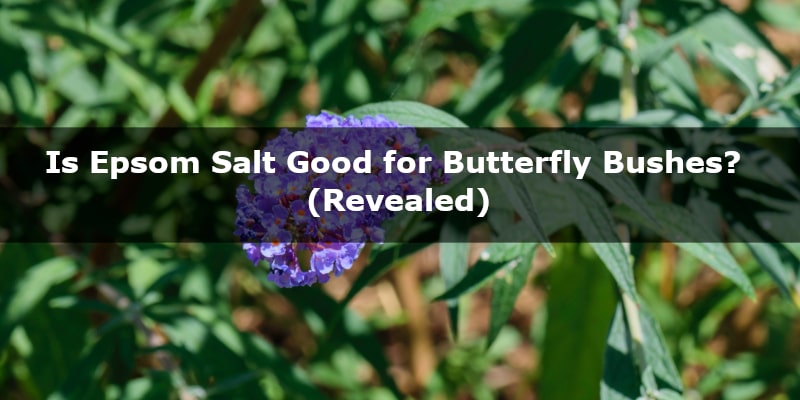Are you planning to apply Epsom Salt on Butterfly Bushes?
Is it a good idea? Keep on reading to find it out!
Is Epsom Salt Good for Butterfly Bushes?
Butterfly Bushes aren’t heavy feeders, and they don’t require fertilizing. However, adding Epsom Salt might be beneficial, as it will make the leaves look greener, deter pests, and neutralize soil pH.
Growing Butterfly Bushes without fertilizing is ok, as long as they’re not grown in clay soil. However, even if the soil is rich, adding Epsom Salt shouldn’t do any harm, as there are 6 main benefits of using Epsom Salt.
Keep on reading to find out how your Butterfly Bushes might benefit, and how, and when to apply Epsom Salt.
Why Put Epsom Salt for Butterfly Bushes?
Adding Epsom Salt to your Butterfly Bushes has many benefits, including:
Better Nutrient Uptake
Epsom salt contains magnesium, which increases a plant’s ability to absorb nutrients, such as nitrogen and phosphorus, without which it would struggle to thrive. Epsom Salt is, therefore, also helpful in ensuring the plant is able to take in the optimum levels of other vital nutrients from the soil.
Greener Plant
Magnesium in Epsom Salt makes Butterfly Bushes greener because it helps in the creation of chlorophyll, which is what determines a plant’s leaf color, and ultimately results in the plant’s foliage appearance. Chlorophyll is also important for the plant to photosynthesize, a process that enables the plant to make food and energy.
Added Micronutrients
Except for magnesium, Epsom Salt contains sulfur. Usually, flowers grown with Epsom Salt as opposed to those grown with just commercial fertilizers produced more flowers with bigger blooms
Deterred Pests
Epsom Salt can help to deter some garden pests, including voles, slugs, or beetles. Treating your Butterfly Bushes with Epsom salts may decrease the number of slugs in your garden, but it shouldn’t be your preferred way of dealing with pests, as other remedies work better.
Balanced Nutrient Levels
Epsom Salt can help balance nutrient levels in particular types of soils. Magnesium is a common nutrient that is deficient in agricultural soil or soil. If the magnesium levels of your soil have been depleted then supplementing your soil with Epsom salts could balance out the nutrient levels and improve future crops.
Neutralized Soil pH
If you have a high soil pH in excess of 7.5 pH, then adding Epsom Salt to it could help to neutralize it. Butterfly Bushes will struggle to grow in soils that are too alkaline, (it grows best in soil pH of 6.0-7.5), so reducing the pH level of the soil in these instances will be very beneficial. The Epsom Salt will gradually increase the acidity of the soil over time.
When Should You Add Epsom Salt to the Butterfly Bushes?
You should apply Epsom Salt to the Butterfly Bushes in the spring before new flowers emerge, and in the fall after flower drop.
Butterfly Bushes aren’t heavy feeders. Therefore, there is no need to fertilize them often.
Fertilizing Butterfly Bushes in the spring when the first leaves appear and there is no more danger of severe spring frosts is a good idea to give your flowers a good start.
Optionally, if the soil is poor you can also apply Epsom Salt in the fall.
Fertilizing Butterfly Bushes more often will cause overfertilization, so Epsom Salt should be used as an additional secondary supplement.
How to Water Butterfly Bushes With Epsom Salt?
There are 2 ways that you can water Butterfly Bushes with Epsom Salt. You can either spray the plant, or water it with a solution of water and Epsom Salt.
To fertilize Butterfly Bushes, add 1 or 2 tablespoons of Epsom Salt to a gallon (4.5 l) of warm water, and shake to combine. A higher ratio won’t be more effective. You can either apply directly to the soil or spray the mixture onto your plants’ leaves for faster absorption.
The amount of magnesium a plant needs is fairly minute, so it’s also very easy to overdo it and overfertilize Butterfly Bushes. Signs that you’ve overdone it include stunted growth and darker leaves.
Can You Apply Epsom Salt on Other Plants?
Yes, applying Epsom Salt on other plants is generally a good idea, but not always. You shouldn’t apply Epsom when:
You Want to Use it as a Main Fertilizer
Nutrients that plants require are nitrogen, phosphorus, and potassium, which are referred to in the gardening world as N-P-K. The nutrient value of Epsom Salt is 0-0-0, meaning they contain no traces of these nutrients. Instead of Epsom Salt, you should be feeding your plants with a balanced fertilizer to help sustain them.
Plants Lack Magnesium
A magnesium deficiency in a plant doesn’t always mean it is growing in magnesium-deficient soil. Some plants suffer from magnesium deficiencies because the soil is too high in phosphorus, which prevents a plant from being able to adequately absorb the soil’s magnesium. Adding Epsom salts in this instance will not make any difference because it is the phosphorus level of the soil, which needs to be decreased to enable a plant to absorb magnesium.
Soil is Acidic
Epsom Salt can be useful at helping to neutralize alkaline soil, and so the opposite would be true in acidic soil. If you have acidic soil, then you should refrain from using Epsom salts in your garden, as this could exacerbate the problem.
That being said, you need to be careful when using Epsom Salt. However, there are plants that will usually need Epsom Salt, and applying it will help. Usually, you can feed these plants with Epsom Salt.
- Roses
- Peppers
- Tomatoes
- Hydrangeas
- Azaleas

